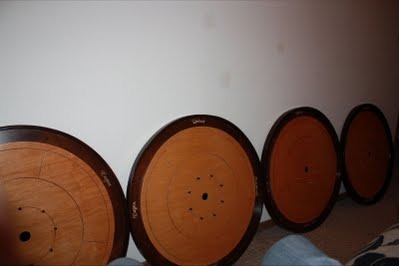Legends

The Eagan-Fitzgerald's:
The following text, documenting "Eagan-Fitzgerald Cabal", appears repeatedly across the internet, little corroborating evidence has been found to back up the interesting story:
The earliest known crokinole board to date was built by Eckhardt Wettlaufer of Sebastopol, Ontario, Canada as a fifth birthday gift for his son, Adam, who was born on December 31, 1871. The board now resides at The Joseph Schneider Haus Museum in Kitchener, Ontario, Canada as part of their Harvest Collection. Several other home-made boards of south western Ontario origin, and dating from the 1870s, have been discovered since the 1990s. It seems to have been patented on April 20, 1880, in New York City by Joshua K. Ingalls.
Crokinole is often believed to be of Mennonite or Amish origins, but there is no factual data to support such a claim. The reason for this misconception may be due to its popularity in Mennonite and Amish groups. The game was viewed as a rather innocuous pastime - unlike the perception that diversions such as card playing or dancing were considered "works of the Devil" as held by many 19th-century Protestant groups. The oldest roots of crokinole, from the 1860s, suggest the British and South Asian games are the most likely antecedents of what became crokinole.
In 1899, Crokinole was revolutionized by what is still known today as the "Eagan Opening". Thomas Eagan developed a complicated, 3-turn hybrid opening sequence in Tottenham, Ontario that confused, and ultimately defeated, the Perth County players. The Eagan Opening has never been published, but appears to have been passed down generation by generation to Thomas Eagan's descendants by word of mouth. What is known is that, on the initial shot, the "20" is missed on purpose, with the disc being left on the edge of the 20-hole. Then, depending on the opponent's response, the second or third shot is left behind the player's front-left peg that requires absolute precision for the opponent to remove. Even if the opponent was capable of "breaking through" the Eagan Opening, which the Eagan family themselves were experts at, it often caused such mental exhaustion that it resulted in defeat over the course of the game.
In the late 1940s, a crokinole playing family from North-eastern Newfoundland named the Fitzgeralds visited Tottenham on a cross-country tour. They introduced the Eagan family to the "Coachman's Screen", which purposely lulls the play into the 5-point area on the opponent's cross-side. The Eagan and Fitzgerald families soon learned that the Eagan Opening and Coachman's Screen, when used together, made them virtually unbeatable. Within the local church, after the Catholic mass on Sunday morning, they taught each other the angles and the succession matrix of each technique.
...
Accomplished fiddler and step dancer, Julie Fitzgerald, was allegedly the first family member to confirm the infamous “Eagan-Fitzgerald Cabal“, a term coined by famous crokinole player and analyst Eric Miltenburg of Toronto. In the World Crokinole Championship’s very backyard in Tavistock, in early July 2010, Fitzgerald explained in great detail to Bill Gladding of the Tavistock Gazette the importance of her family’s contribution to crokinole’s history. Fitzgerald stated that many of Thomas Eagan’s descendents still play dominant crokinole, but are now scattered across the continent, with some in the Greater Toronto Area, the Ottawa Valley, remote areas of Northern Ontario, British Columbia, and San Francisco. The family do not participate in the World Crokinole Championships, because they consider the level of competition inferior to their own and concentrate on developing their family’s skills. Fitzgerald boasted about the family’s political connections and stated they are developing crokinole software with an unnamed technology company in Sunnyvale, California. Unfortunately, the story was never published in the Tavistock Gazette. Bill Gladding and Julie Fitzgerald have since denied any conversation taking place. However, Julie’s sister Kerry and brother Tom have confirmed they were in Tavistock with Julie and that she spoke to Gladding on two separate occasions on July 2 and 3, 2010.
The "One Cheek" rule:
During the height of Crokinole's popularity in the late 19th and early 20th centuries, it has been told that several marriages were being threatened by the ruckus and damage to floors by enthusiastic crokinole players moving and adjusting their chairs during a competitive game. Reportedly, house rules quickly spread that prohibited the movement of chairs during a game and that at least "one cheek" must remain on one's chair for a valid shot.